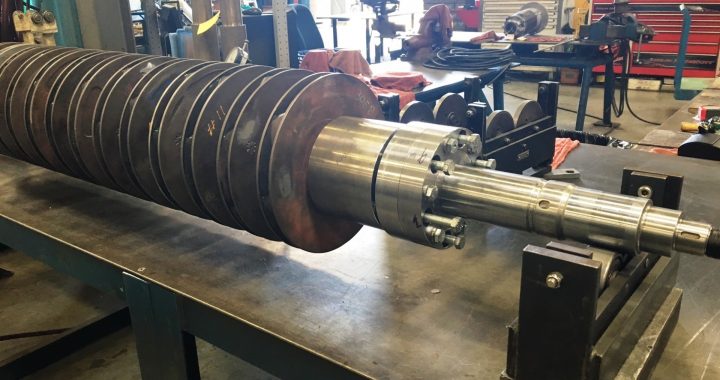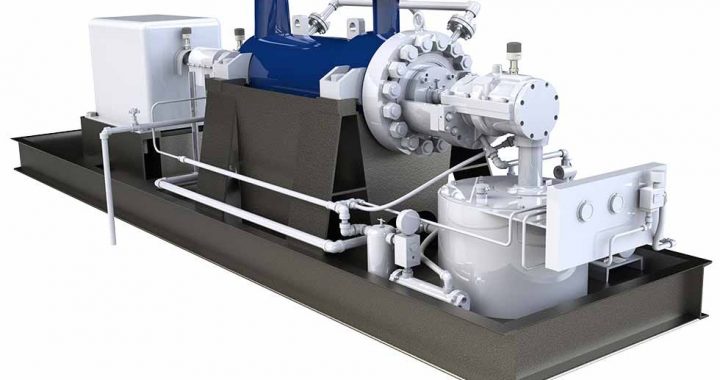Hydro Reliability Services was called into a combined-cycle plant to determine the condition of the plant’s two condensate pumps. Losing one of the pumps to failure would cause the plant to be vulnerable to unplanned downtime and huge expenses.
Case Studies
Repairing a Fleet of Pump Trains After Hurricane Harvey
HydroTex repaired and tested a batch of over 20 pump trains from a Texas energy company. Due to the way the pumps were stored, each came with its own set of unique challenges.
In 2008, a large energy company in Texas purchased over 20 complete pump trains, including motor skids, pumps, and all the components. While they were waiting to be installed, the pumps were store in a laydown yard and suffered severe water damage when Hurricane Harvey, a category 4 storm, made landfall in Texas in August 2017, causing catastrophic flooding throughout the area. To complicate matters further, in 2019, Tropical Storm Imelda caused further damage to the equipment.
In early 2020, the energy company sent the weather-damaged equipment to HydoTex Golden Triangle in Beaumont, Texas for a complete evaluation, repair, and high-quality performance testing.
All 20+ pump trains had similar damage, but each one had its own unique repair scope. HydroTex was able to create plans to appropriately refurbish all of the pumps. The plans ensured that the pumps would be tested to verify proper mechanical and hydraulic performance. HydroTex initiated reverse engineering on all the equipment and major components while sending the motors to a vendor in Baton Rouge, Louisiana.
To verify the quality of each repair scope, HydroTex offered to include a mechanical run test of each pump and Hydro’s Performance Test Lab in Chicago. The mechanical run test would verify that the refurbished pump operated with minimal vibrations and expected thermal increases during operation. This test would provide assurances to the end-user that when it comes time to install each pump that they can expect reliable performance and an extended lifespan of the pump.
In addition to a mechanical run test, the Hydro’s test lab was able to provide a complete hydraulic performance test. By adding this service, the end-user would be able to confirm that the pumps would meet the process conditions necessary to perform when installed. The assurance of mechanical performance and hydraulic performance provided the best decision-making information to the end-user, setting them up for long-term success with these pumps, and building trust in the quality of the repair.
The fully refurbished and performance-tested equipment is now stored in an indoor storage facility rather than an open yard with exposure to the elements.
The 20+ pump trains were prioritized into three sets. HydroTex delivered all the refurbished equipment in record time—less than a year. Even with delays caused by a global pandemic, HydroTex was able to deliver the first priority set, with the second set delivered a month later, and the third set delivered within the following month. Each had to be individually assessed with specific plans of action and specific performance testing.
Some of the repairs required were more intricate and meticulous than others. These are complete pump trains and not only individual pump repair. HydroTex also repaired all the skids, all the seal changes, all couplings, and coupling guards, the bases, and the foundations.
Read the article in Pumps & Systems here.
Refurbishing a Contaminated Nuclear Casing
Creative approaches that extend beyond original designs, standard tools, and traditional engineering practices can provide significant savings and higher reliability of pumping equipment. For example, in one such situation, the casing of a charging pump at a European nuclear plant had been over-pressurized and needed to be refurbished. Not only was the pump service radioactive, but the casing was also found twisted with its internal components unable to properly fit into the casing, and the machined surfaces out of alignment.
The original equipment manufacturer (OEM) of the pump stated that they could not repair the casing and that the only option was to purchase a new one. The nuclear plant’s engineers approached Hydro, Inc., a global aftermarket pump service provider, for assistance in finding a spare casing. When no spare was found, Hydro initiated a more detailed discussion with the plant about refurbishing the casing.
Hydro’s team inspected the pump, the casing, and the internal element and explored all possible options (Figure 1). Hydro was able to find an inventive solution by machining the casing in the contaminated state and developing creative methods to guarantee a proper fit-up when the casing repair was completed. Despite the OEM suggesting a new pump be purchased, the service provider was able to find an innovative and cost-saving way for the plant to repair the casing and reduce downtime. Continue reading
Analysis & Engineering Upgrades Solve Ring Section Pump Failure
A major power plant in the United States experienced high vibration and recirculation issues with several ring section (BB4) boiler feed pumps, resulting in multiple catastrophic failures and unplanned outages. This case study details one of the pumps that was shipped to an aftermarket pump service center for a full analysis, troubleshooting, repair plan, rebuild and performance testing.
In combined-cycle plants, the demand for robust, yet expensive, barrel pumps diminished as the industry moved toward less expensive segmental rings pumps. Due to the recent shifts in the power industry, operators often face a shorter mean time between repair (MTBR), internal wear and high vibration issues on newly installed units.
After experiencing numerous boiler feed pump performance and reliability issues at their power plant, the plant owner opted to pursue a comprehensive root cause analysis and repair plan with an aftermarket pump service center in Los Angeles, California. The investigation ultimately revealed a series of underlying issues linked to the performance problems and unexpected pump failures.
Video: https://vimeo.com/452266877
Source: https://www.pumpsandsystems.com/analysis-engineering-upgrades-solve-ring-section-pump-failure
Wireless Sensor Data Integration Into Existing Plant Historian
A large American energy company wanted a new data collection system to be integrated into its site historian along with process trending software to better diagnose system-related issues that can lead to maintenance issues.
Thanks to the help of an aftermarket service company, the energy company combined multiple sources of data and can now view complex mechanical vibration phenomena in parallel with plant process data. By comparing the two sets of data side by side, plant personnel will correlate process conditions with mechanical vibration data.
The service provider’s history of pump and rotating equipment knowledge helped to provide actionable analysis of pumps and other rotating equipment health—and a mechanism to provide additional engineering solutions to complex problems. Combined with the energy company’s focus on reliability and a history of maintaining their equipment, this system provided an improved method of data collection and analysis.
Source: https://www.pumpsandsystems.com/wireless-sensor-data-integration-existing-plant-historian





